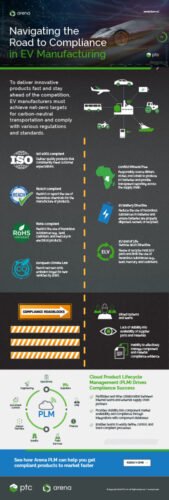Regulatory Compliance Essentials for EV Manufacturers
 The regulatory landscape for electric transportation is becoming increasingly complex as electric vehicles (EVs) continue to gain momentum and new technologies emerge. Keeping track of the ever-changing requirements can be overwhelming for EV manufacturers due to the compressed timelines, part shortages, and other obstacles they face in getting products to market.
The regulatory landscape for electric transportation is becoming increasingly complex as electric vehicles (EVs) continue to gain momentum and new technologies emerge. Keeping track of the ever-changing requirements can be overwhelming for EV manufacturers due to the compressed timelines, part shortages, and other obstacles they face in getting products to market.
Failure to comply with regulations can derail product launches or, even worse, result in costly fines or company shutdowns. To mitigate risks, manufacturers must gather compliance evidence throughout the product lifecycle. Corrective actions, standard operating procedures (SOPs), and other quality processes must also be in place to ensure that the right product gets built while meeting safety and sustainability requirements.
Preparing for regulatory audits and certifications often takes a toll on an organization’s time and resources. And with teams becoming more dispersed due to the pandemic, it can be difficult for stakeholders to keep track of compliance data, required action items, and deliverables.
The following checklist highlights key steps your organization can take to prepare for an upcoming audit and streamline compliance processes.
EV COMPLIANCE READINESS CHECKLIST
1. Familiarize yourself with all applicable regulations and standards.
Various regulations and standards related to electric mobility have been introduced to address environmental impact, product safety, and reliability. Your quality assurance team should monitor these regulations on a routine basis to ensure business alignment. It’s also important to train employees so they have a clear understanding of the protocols they should follow to achieve compliance.
ISO and IEC Standards
The International Organization for Standardization (ISO) and International Electrotechnical Commission (IEC) have published several standards, including ISO 6469, to enforce protection against electrical hazards and system failures. In addition, guidelines for information security management (i.e., ISO/IEC 27000) address underlying technologies such as the Internet of Things (IoT) or charging infrastructure which can pose cybersecurity or privacy risks.
ISO 15118 provides protocols for bidirectional communication between the EV and charging station so drivers can plug in the vehicle and charge without having to use cards, apps, or PINs for authentication and billing. Also, the different modes for EV conductive charging systems are outlined in IEC 61851.
Although ISO 9001 is not specific to electric transportation, companies across many sectors use it as the basis for implementing a quality system and driving continuous improvement.
Environmental Regulations
Environmental regulations such as Registration, Evaluation, Authorisation and Restriction of Chemicals (REACH) and Restriction of Hazardous Substances (RoHS) limit the use of hazardous materials for the production of products. Other regulations like the EU Battery Directive, EU End of Life Vehicle (ELV) Directive, and Waste Electrical and Electronic Equipment (WEEE) require manufacturers to reuse, recycle, or properly dispose of certain parts and materials once they are retired from operation.
2. Perform an internal assessment.
One of the best ways to prepare for an upcoming audit is to conduct an internal assessment using either your own team members or an external third-party auditor. A self-assessment enables you to gauge your organization’s compliance readiness and identify any gaps that need to be addressed prior to the actual certification process.
3. Develop an action plan.
Based on the findings from your internal assessment, develop an action plan for implementing the necessary changes to help your organization reach compliance. When assigning tasks and due dates to impacted teams, take into account the date of your formal audit. Allow sufficient time to train employees on any new processes so that everyone is on the same page. Also keep senior management in the loop to ensure that you stay on schedule.
4. Compile your product record and history.
By bringing together the key elements of your product record which includes bills of materials (BOMs), corrective and preventive actions (CAPAs), SOPs, requirements, training documentation, and engineering change orders (ECOs) in a centralized system, you’ll always have the necessary evidence at hand to demonstrate compliance.
5. Leverage a digital solution to manage compliance.
Managing regulatory information in context with the product record makes it easy for your teams to track key deliverables and quickly address compliance issues that could hinder product launches.
Proven cloud-based product lifecycle management solutions like Arena PLM help you simplify product compliance by linking the required product and quality records in a single, unified platform. Revision controls and automated engineering change processes are applied to technical files, SOPs, training records, and other documentation necessary for compliance. This instills confidence that the information is always accurate and up to date.
Integrations with component databases like Octopart and SiliconExpert also enable you to gather, manage, and track materials compliance evidence for regulations such as RoHS, REACH, and conflict minerals. And because product information and associated documentation is readily available, you can present proof to auditors at a moment’s notice.
TAKING A PROACTIVE APPROACH
Compliance cannot be an afterthought for EV manufacturers if they want to win the race in today’s volatile and highly competitive market. Implementing the right systems and processes early on will help you stay on top of the evolving industry mandates and minimize risks. Ultimately, this proactive approach to compliance will be key to accelerating your product launch and achieving commercialization success.
Are you an EV manufacturer? How do you prepare for audits? Share your tips with us on social!
To learn more about navigating compliance and other obstacles in EV manufacturing, visit our resource page.



 View Full Infographic
View Full Infographic